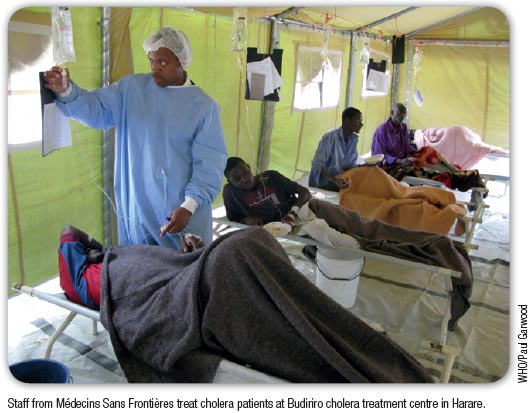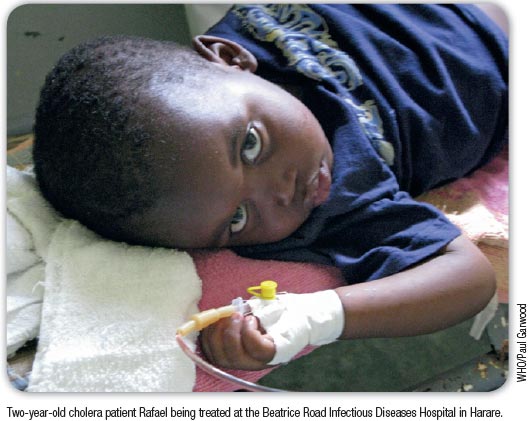NEWS
An old enemy returns
The recent cholera outbreak in Zimbabwe highlights failures in the global fight against an old enemy. Sarah Cumberland reports.
The recent cholera outbreak in Zimbabwe is not only symptomatic of the breakdown of water and sanitation infrastructure, but also of the restricted availability of a simple life-saving treatment - oral rehydration salts (ORS) solution. While little can be done in the short term to improve access to safe water and appropriate sanitation, treatment with ORS solution for cholera - an acute intestinal infection that causes severe diarrhoea - has become more widely available to those afflicted.
In early January, 600 new cases of cholera were being reported daily with 5-8% of victims dying. Nearly half of those deaths occurred at home. According to Dr Claire-Lise Chaignat, from WHO's Global Task Force on Cholera Control, a possible 80% of those afflicted could have been treated successfully with oral rehydration therapy, which can nearly eliminate deaths. "Dehydration can kill a healthy adult in a matter of hours," she says. "Severe cases may need intravenous fluids, but most people can be saved by ORS." In its simplest form, ORS is a solution made of glucose and various salts dissolved in clean water and administered to patients with life-threatening diarrhoea to prevent dehydration.
Credited with preventing an estimated 40 million deaths since it was formally endorsed by the World Health Organization (WHO) in 1978, ORS therapy is the cornerstone of case management for acute diarrhoea, and therefore for cholera. "ORS is a life-saving treatment that is safe for people to use [themselves] at home," says Chaignat. "In fact, it's important that it can be used at the household level while people are waiting to access proper health care."
So why, 30 years after they became the essential element of cholera outbreak response, were ORS not made available for people to use at home in Zimbabwe? Dominique Legros, from the Disease Control in Humanitarian Emergencies (DCE) programme at WHO, said the government in Zimbabwe was promoting self-medication with home-made solutions of sugar and salt.
"Unfortunately, the cholera epidemic has struck at a time when most Zimbabweans are unable to purchase salt and sugar," says Francesco Checchi, also from DCE at WHO.
The absence of such basics is symptomatic of a broader collapse. "There are few cholera treatment centres, and people can't afford to travel or are too sick to catch a bus [to travel there ]," says Paul Garwood of the Health Action in Crises team at WHO. "Hospitals are empty; water and sanitation are poor." But this year the cholera situation may start to improve.
In early December 2008, WHO advised the Ministry of Health and Child Welfare to endorse the administration of ORS solution by people with no health-care training to treat diarrhoea in the home in line with WHO policy, according to Dr Custodia Mandlhate, WHO Representative in Zimbabwe. In conjunction with the Ministry, WHO has now established a Cholera Command and Control Centre, with a team of epidemiologists, logisticians, water and sanitation experts and health workers, with the aim of executing a coordinated response.
Zimbabwe's initial reluctance to mount an effective response early on, or even to admit that an outbreak was occurring, is not unique. "Countries often fear their tourism and trade will be affected," says Chaignat. "They are scared of stigmatization."
WHO estimates that about 120 000 people died of cholera in 2007, while millions more were infected, numbers that are in stark contrast to official figures that countries report to WHO. "The official numbers reported [for that year] to WHO were 4031 deaths and 178 000 cases," Chaignat says. Underreporting is the norm not only for cholera but for other diseases, including typhoid fever, shigellosis, leishmaniasis and yaws.
Cholera-like diseases have been described in the ancient Chinese, Greek and Sanskrit literature. Since the 19th century, cholera has been particularly associated with the fertile Ganges river delta, with its labyrinth of waterways and swamps. Seven cholera pandemics - large-scale epidemics affecting several countries - have sent waves of the disease across the world since the 1800s.
The communities that have suffered the most from the devastating effects of this disease treat it like a fact of life and, even where simple, affordable treatment is available, the illness carries an immense stigma. "People see it as a dirty disease," Chaignat says. "People don't want to talk about it. They think it's normal to have diarrhoea. Quite often, nobody is interested in providing the minimal support needed for prevention."

One of Europe's worst cholera years on record was 1854 when 23 000 people died in Great Britain and Ireland alone. That was also the year that English physician John Snow first demonstrated the link between contaminated water supplies and the spread of cholera. Another milestone in the fight against cholera came in 1883 when German physician Robert Koch - one of the first doctors to study bacteria - first isolated Vibrio cholerae, the bacterium that causes cholera, while studying outbreaks of the disease in Egypt and India.
Despite the fact that ORS solution is an effective treatment for dehydration from the disease and despite the existence of a cholera vaccine - albeit an unsatisfactory one due to its two-dose regimen, short shelf-life, high cost and need for cold chain distribution - prevention must be at the heart of any effective long-term response. "There is an urgent need to provide a programmatic, concerted and coordinated approach to cholera control," says Chaignat. "Prevention, preparedness and response activities together with an efficient surveillance system are paramount."
Dr Madhu Ghimire, from the Department of Communicable Diseases at WHO's Regional Office for South-East Asia, concurs: "The approach to cholera outbreaks in many developing countries has been that of reactive response directed at controlling outbreaks and minimizing mortality. Little or no proactive measures are taken to prevent cholera," he says.
Prevention is, for the most part, a question of ensuring hygiene. In other words, the front line with cholera is the village latrine and drinking-water supply. Referring to improvements in drinking-water and sanitation in the mid-19th century in Europe after Snow's discovery, Legros says: "The last cholera outbreaks in western Europe were in the 1860s. If a country can provide safe water supplies and sewage systems to everyone, then outbreaks will disappear." Around 90% of diarrhoeal diseases can be attributed to contaminated water and/or food, as well as to inadequate sanitation and hygiene. However, in Zimbabwe, little can be done in terms of improving access to safe water and appropriate sanitation in the short term. Legros says the focus there is very much on the immediate need to treat sick people.

Checchi believes that many of the severe outbreaks of cholera that occurred recently have been caused by consumption of water from contaminated sources. "In the case of Zimbabwe it is due to damaged urban water-piping systems," he says, adding that the problem has been further fuelled by inadequate sanitation, mainly excreta disposal, which results in bacteria being fed back into the water sources. Basic hygiene education, which may be as simple as teaching people the importance of hand-washing, is also needed. It is estimated that such practices can reduce diarrhoea cases by around 45%.
More than one billion people in the world do not have access to safe drinking-water, while 2.5 billion lack adequate sanitation. Given that the global situation is unlikely to change in the near future, WHO and its partners are left relying for the most part on surveillance, forecasting and responding to cholera outbreaks and monitoring hot spots, mainly in large parts of Africa, Bangladesh, China, India, Indonesia, Pakistan and the Philippines. But predicting the location and timing of a re-appearance of cholera is not so easy. "Every year or two we have a large cholera epidemic somewhere in the world," says Chaignat. "But we only know about the official notifications. In India, for example, only lab-confirmed cases are reported. Worldwide, many people die of cholera without ever reaching a health-care centre."
The global cholera picture is likely to remain a challenge. Population shifts from rural to urban areas in low-income countries exacerbate the growth of shanty towns and slums where cholera thrives. "With changing climate scenarios and ever-increasing conflict situations around the globe, outbreaks are possible anywhere and at any time," says Ghimire, arguing that sound surveillance, preparedness and a capacity for rapid containment should remain "the key tools" for every country. 
